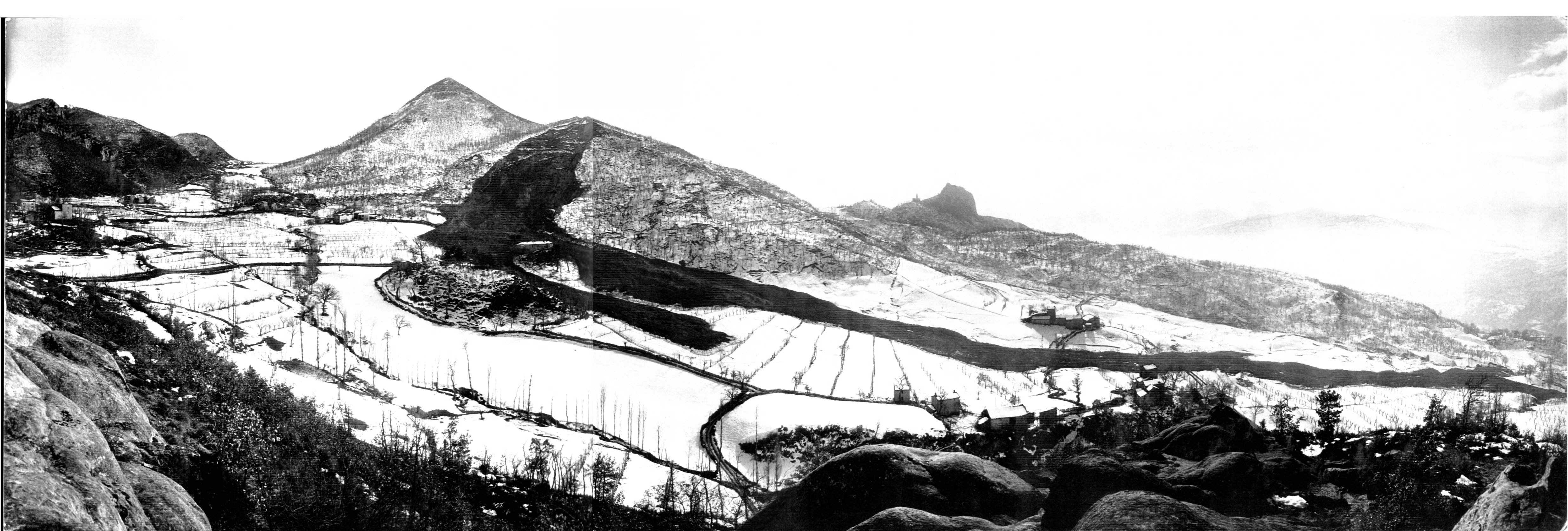Historical archive of landslide events
Description of available regional data pertaining to historical landslides
About the historical landslide catalogue
The historical catalogue of landslides in Emilia-Romagna collates information on the exact location and date of activation or reactivation of landslides which occurred in the region over a time period stretching from medieval times up to 2005. The search for relevant data, which is still ongoing, was initiated in the 1990s under the remit of the Geological, Seismic and Soil Survey, the National IFFI Project (Italian Landslides Inventory), the European RISKAWARE Project and in partnership with CNR IRPI of Turin and the Reno River Basin Authority which compiled an analogous catalogue for the Province of Bologna and part of the Province of Ravenna. For each landslide identified, information has been deduced as to the type, dimensions and effects on the territory, if any.
Aim of historical data collection

Figure 1 - Landslide at Vimignano (BO) - January 1952
The collection of historical data for the study of past landslides facilitates completion and significant improvement of the knowledge framework established through standard geological-geomorphological analysis, whose main products are landslide maps, with better definition of several aspects which are essential for territorial hazard and vulnerability assessment.

Figure 2 - The same area of Figure 1 as it appeared in 2003 ( landslide perimeter in red)
Meticulous archive research spanning a significant period of time enables us not only to glean information on past landslides of which no visible traces remain, but also to delineate the evolution of landslides still visible today, to improve our knowledge of the particular characteristics of individual landslides, such as their driving factors and main triggering mechanisms (adverse climatic conditions, earthquakes, etc.), the return period, the dynamics of the landslide and lastly, detailed information on the effects on the territory.
This information, rarely extrapolated through direct surveying, is essential for piecing together a complete picture of the level of development of the landslide itself, allowing us to establish links between cause and effect. This facilitates the elaboration of models based on historical information which can help prevent future landslides. Accurate reconstruction of landslide evolution is extremely useful not only in the territory in question, but also in environments with analogous characteristics.
Lastly, historical documentation on landslides indubitably constitutes information of vital importance to urban and territorial planning, preserving the memory of historical events which occurred in the distant past but which must be taken into account due to their possible effects on current and future settlements (see figures 1 and 2).
Sources consulted
In an effort to improve the comprehensiveness of research, various documentary sources were analyzed:
- scientific, geological and technical documentation produced from the latter half of the 19th century on;
- technical-administrative documentation produced or gathered by mostly public bodies from the 19th century on;
- national and local periodicals, regularly published from the mid 1800s on;
- historical, archaeological and naturalistic literature, both published and unpublished;
- previous archives;
The diverse nature of the sources, while posing some problems in terms of extrapolating homogenous data, provided a far more complete census of landslides (although the number of events recorded is inversely proportional to their remoteness in time from the present day) and more complete information on individual events. In general, scientific publications describe geological-technical aspects of a limited number of landslides in great detail, with limited information on their chronology. Technical and administrative reports provide detailed accounts of affected areas, often with the aid of large scale maps, and the repercussions of landslides on the territory and anthropic activity; in many cases they make it possible to pinpoint more or less exact dates. The periodical press, which charts events as they unfold, enables us to precisely pinpoint the dates of landslides and, sometimes, to ascertain an accurate chronology of the evolution of certain landslides. Historical literature, together with administrative acts passed by pre-unification administrations, represents the only source of news pertaining to landslides which occurred prior to the 19th century.
Content of historical catalogue
(JPEG - 93,7 KB)Fig.3 Location of reported landslides in the catalogue until 2005 - enlarge image (JPEG - 93,7 KB)
The historical catalogue has been compiled on a provincial basis over the past 10 years and features slightly differing data structures depending on the date of completion and the territory covered. The fundamental data for every landslide, given for all areas, are:
- the date of activation (with varying degrees of precision, depending on the event);
- the administrative location (Province, Municipality);
- the area affected by the movement and the competent Basin authority;
- the main descriptive characteristics of the landslide;
- the triggering mechanisms (if indicated in the original documents);
- the dimensional parameters (if indicated in the original documents);
- the effects on the territory and on anthropic action, plus any interference with the hydrographic network, when available;
- information sources;
Starting from the documentation collected, the majority of events described were pinpointed on a topographic map to scale 1:10.000. Each event is represented by a dot. In those cases where it was impossible to mark the site, the information on the landslide was nonetheless recorded in the database.
The catalogue has been completed for the provinces of Reggio Emilia (data available up to 1994), Modena (2002), Forlì (2003) Ravenna (2005) and Rimini (2005); for Bologna and part of the province of Ravenna the catalogue was completed (2005) by the Reno River Basin Authority; the sections of the catalogue relating to the provinces of Parma and Piacenza are nearing completion while data on the province of Reggio Emilia is soon to be updated to 2006.
Table 1: Number of Landslides with reports recorded in the historical catalogue of landslides, per individual province: note that each landslide body may have numerous reactivation reports
Province | N. of landslide bodies recorded in the historical landslide catalogue |
|---|---|
Piacenza | Nearing completion |
Parma | Nearing completion (476) |
Reggio Emilia | 610 |
Modena | 1279 |
Bologna | 1227 |
Ravenna | 395 |
Forlì-Cesena | 597 |
Rimini | 313 |
Access to data
- Webgis on landslide carthography (italian language)
The complete data on the various provinces, both tabular and geographic, including relative technical descriptive notes, are available for download and online consultation.

